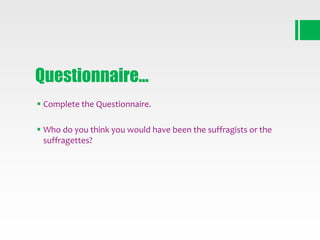914 - Publicity
- 1. Questionnaire…  Complete the Questionnaire.  Who do you think you would have been the suffragists or the suffragettes?
- 2. WALT: How did the Suffragettes get publicity? WILFS. 5 – Explain what the suffragettes did. 6 – Compare several sources as evidence. 7 – Evaluate the usefulness of the sources.
- 3. Publicity.  Suffragette activity can be summed up in one word – PUBLICITY.  By the 1900’s most MPs were actually in favour of votes for women, but it was an issue they could easily ignore.  Discuss how could you get publicity? What could you do?
- 4. TASK  You will work with the person next to you.  You have 4 minutes to examine the picture and information in front of you. Think about the Questions on the sheets.  In your books – Answer how each is an effective method of getting publicity.  Source One – Chaining ……
- 5. 1 Chaining to railings. Suffragettes chained themselves to railings so that they had more time to protest before police took them away. Q. Police brutality! How would you react to seeing this poor women being mistreated. Q. What could have happened before this picture? Q. Is this just police overreaction?
- 6. Newspapers. The Suffragettes published their own weekly newspaper Votes for Women. It was sold in shops all over Britain and on the street by suffragette members. Women had to stand in the street to sell their newspaper because they could be arrested for obstruction if they stood on the pavement. The newspaper had pictures and articles about suffragette processions and meetings, fund raising reports and letters. Prizes of bicycles painted in the suffragette colours were given to the women who sold the most copies. Q. How does this increase publicity? Q. What Questions do you want answered from this image. 2
- 7. Banners. The Suffragettes insisted that banners should be made skilfully and with good materials. Their rules were: ‘Never use anything that is ugly’. ‘If it is not exactly right it won’t do at all’. ‘Do not use the wrong colour.’ Q. Why would be so important to be consistent? Q. What might this consistency say about the suffragette movement? THINK - Organised or Disorganised? 3
- 8. Processions. In 1908, 300,000 suffragettes joined a march to Hyde Park. The marchers wore white, green and purple as a uniform. Six brass and silver bands played suffragette songs. Q. How would the Government react? Q. How would the country react? 4
- 9. Photo Opportunities. Christable Pankhurst buying heather to welcome the ‘Scotch Lassie;. Mary Phillips on her release from prison in 1908. She was the longest serving suffragette prisoner. Q. Why would the suffragettes want this photo taken? - Would they want the image reproduced? 5
- 10. Chalking. Emma Sproson and a friend chalking a suffragette message. In the suffragette colours of purple, white and green in 1907. Q. Why would this picture have been taken? 6
- 11. Task  Choose at least two sources to write about.  Suffragette supporters took these photographs. Does this affect their value to historians?  What are the advantages and disadvantages of a photograph to Historians?  Source 1 (an image of suffragettes being chained to a fence) is useful to historians because it shows … However the photograph does not show the full events …
- 12. Homework  Create a newspaper articles for the ‘Votes for Women newspaper’.  Create a recent publicity stunt, what was the aim, did it achieve anything?











